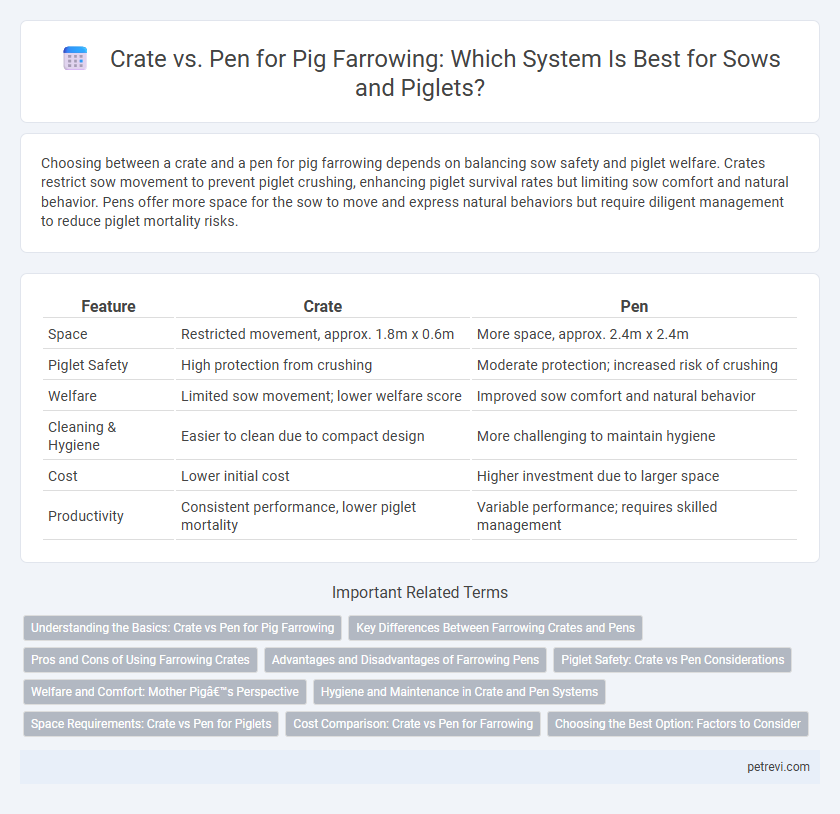Choosing between a crate and a pen for pig farrowing depends on balancing sow safety and piglet welfare. Crates restrict sow movement to prevent piglet crushing, enhancing piglet survival rates but limiting sow comfort and natural behavior. Pens offer more space for the sow to move and express natural behaviors but require diligent management to reduce piglet mortality risks.
Table of Comparison
| Feature | Crate | Pen |
|---|---|---|
| Space | Restricted movement, approx. 1.8m x 0.6m | More space, approx. 2.4m x 2.4m |
| Piglet Safety | High protection from crushing | Moderate protection; increased risk of crushing |
| Welfare | Limited sow movement; lower welfare score | Improved sow comfort and natural behavior |
| Cleaning & Hygiene | Easier to clean due to compact design | More challenging to maintain hygiene |
| Cost | Lower initial cost | Higher investment due to larger space |
| Productivity | Consistent performance, lower piglet mortality | Variable performance; requires skilled management |
Understanding the Basics: Crate vs Pen for Pig Farrowing
Crate farrowing systems restrict sow movement to minimize piglet crushing and improve piglet survival rates, while pen systems provide more space for natural behaviors, enhancing sow welfare and reducing stress. Studies indicate that farrowing crates can increase piglet mortality due to restricted maternal behavior, whereas pens allow better sow-piglet interaction but require attentive management to prevent piglet loss. Selecting between crate and pen farrowing involves balancing piglet mortality risks with sow welfare, guided by farm goals and animal welfare standards.
Key Differences Between Farrowing Crates and Pens
Farrowing crates restrict sow movement to minimize piglet crushing, providing controlled environments that enhance piglet survival rates. In contrast, farrowing pens offer more space and freedom of movement for sows, promoting natural behaviors but potentially increasing piglet mortality. The choice between crates and pens involves balancing pig welfare priorities with productivity and piglet safety outcomes.
Pros and Cons of Using Farrowing Crates
Farrowing crates provide improved sow protection by restricting movement, which reduces piglet crushing and increases survival rates during farrowing. However, these crates limit sow mobility, raising animal welfare concerns due to stress and discomfort. Pens offer sows more freedom of movement and natural behavior expression but have a higher risk of piglet mortality from crushing.
Advantages and Disadvantages of Farrowing Pens
Farrowing pens provide increased freedom of movement compared to crates, promoting natural behaviors and improving sow welfare by reducing stress and injury risks. These pens offer better ventilation and space, which can enhance piglet survival rates, but they require more room and vigilance to prevent piglet crushing. Despite higher management demands, farrowing pens align with animal welfare guidelines and can lead to healthier sows and piglets if monitored properly.
Piglet Safety: Crate vs Pen Considerations
Piglet safety during farrowing is critically influenced by housing choice, with crates providing restricted movement that reduces piglet crushing risks by sows, unlike pens that allow more freedom but increase injury potential. Farrowing crates enhance piglet survival rates through controlled sow behavior and easier monitoring, while pens require enhanced management to mitigate safety hazards. Selecting between crates and pens involves balancing piglet protection against sow welfare needs, prioritizing design features that minimize mortality.
Welfare and Comfort: Mother Pig’s Perspective
Crate farrowing restricts a mother pig's movement, often leading to stress and discomfort due to limited ability to nest-build or turn freely. Pen farrowing enhances welfare by providing more space for natural behaviors, reducing stress, and improving overall comfort during farrowing and lactation. Studies indicate pens contribute to better physical health and lower aggression, promoting a more positive maternal experience.
Hygiene and Maintenance in Crate and Pen Systems
Crate systems offer easier hygiene management by restricting pig movement, reducing waste spread and facilitating targeted cleaning. Pen systems, while providing pigs more space and movement, pose challenges in maintaining cleanliness due to increased waste dispersion. Regular maintenance in crates requires focused waste removal and disinfecting, whereas pens demand comprehensive cleaning protocols to control odor and prevent disease transmission.
Space Requirements: Crate vs Pen for Piglets
Farrowing crates typically require less space per sow compared to pens, measuring around 7 by 6 feet, designed to restrict movement and protect piglets from crushing. In contrast, farrowing pens offer larger areas, often exceeding 10 by 8 feet, providing piglets with more room to move freely and promote natural behaviors. The increased space in pens supports better piglet socialization and comfort but demands higher facility costs and space management.
Cost Comparison: Crate vs Pen for Farrowing
Pig farrowing crates generally incur higher initial construction and maintenance costs compared to farrowing pens due to their specialized design and materials required for confinement. However, farrowing pens may lead to increased labor expenses and potential piglet mortality, which can result in higher overall costs despite lower setup fees. Evaluating the cost-effectiveness between crates and pens requires balancing upfront investments with long-term operational expenses and piglet survival rates.
Choosing the Best Option: Factors to Consider
Crate and pen designs for pig farrowing differ significantly in space allocation, sow comfort, and piglet safety, with crates offering restricted sow movement to minimize piglet crushing, while pens provide more freedom but require careful management. Factors such as litter size, farm infrastructure, and labor intensity influence the suitability of either option for optimal piglet survival and sow welfare. Assessing ventilation, hygiene, and ease of monitoring are essential when choosing the best farrowing system tailored to production goals and animal health standards.
Crate vs Pen for Pig Farrowing Infographic

 petrevi.com
petrevi.com